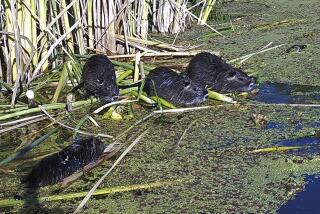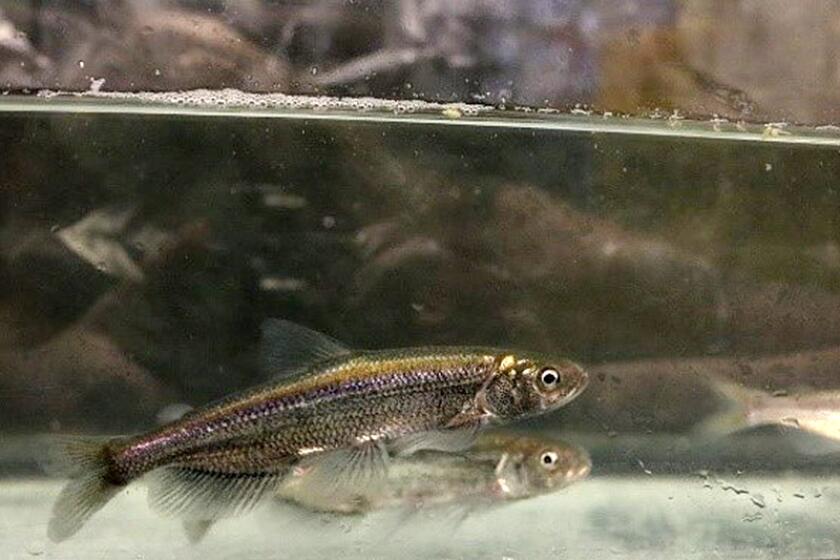Frustrated Fishermen
- Share via
The fishermen stared across Anaheim Lake, where dark, crouching birds peered into the gently rippling water. Long-necked and hungry, cormorants were on the prowl. One bird glided swiftly onto the water.
“There they go, raising hell,” said Fullerton angler Jim Davis, 51.
The waters churned in a frothy white tumult.
“Probably got a big one,” said David Piskorz, 49, of Anaheim, with a mixture of envy and disgust.
Awkward-looking on shore, the cormorant became a picture of lethal grace underwater. In seconds the bird emerged victorious, a fat catfish in its pouched beak as it flapped ashore at the artificial lake in industrial northeast Anaheim.
Cormorants have been feasting on hundreds of thousands of dollars worth of stocked fish each year at private lakes and city parks across Southern California, irritating the small-business owners who stock them, as well as the anglers who want them. While cormorants aren’t the only avian fish eaters, they are among the most aggressive. And because they are protected under the federal Migratory Bird Treaty Act, there’s not a thing anyone can do about it.
Except swear like sailors, or sneak the occasional potshot with a rock.
“It’s really difficult not to get a .22 with a silencer and infrared, and knock those stupid birds off their trees when you see them eating all the fish,” said Rick Mendoza, owner of a 44-acre lake in Laguna Niguel Regional Park. He estimates that he loses about $40,000 in stocked fish to cormorants each year.
Jeff Sun, 31, a forklift operator from La Mirada, created a petition in January on his fishing Web site, https://www.fishinghotpage.com, to denounce the cormorants. About 150 people from throughout Southern California have responded.
In sometimes rambling missives, people call cormorants “nasty little creatures,” “black pests,” “crazed fish-eating machines,” and “ugly black buzzard-like birds.”
Sun said he wasn’t surprised by the number of responses.
“As a fisherman, I get disgusted,” Sun said. “The [cormorants] are getting nice and fat.”
The scenes that prompt such grumbling are not sylvan lakes in the middle of a breathtaking wilderness. Whittier’s Legg Lake, Echo Park Lake in Los Angeles and El Dorado Park Lake in Long Beach are just some of the artificial ponds with sizable numbers of cormorants during prime fishing seasons. Elsewhere, the lakes are even ringed by smokestacks and drab industries.
Still, the men who pay $16 to fish at Anaheim Lake cling to the hope of landing a “big one,” to wrestle with nature and win. The last thing they want is nature interfering with the experience.
And fishing in urban lakes is usually not the challenge it is in natural lakes or roaring rivers.
When water storage facilities like Anaheim Lake and others in the Santa Ana River basin are drained, you can easily see why: The lakes are basically huge mudholes. Fish have few if any places to hide. This is good not only for anglers, but also for birds and even other predatory fish.
Environmentalists and federal and state officials, however, contend that the problem posed by cormorants is greatly exaggerated. They note that there are at most 22,000 cormorants along California’s coast, not the hundreds of thousands as in the Great Lakes region, let alone the huge flocks reminiscent of Alfred Hitchcock’s “The Birds” that some lake owners and anglers have claimed. One official said some fishermen just have a bad attitude.
“The point of fishing is not to catch a fish every time you throw your line into the water,” said Diego Busatto of the state Department of Fish and Game. “This isn’t shooting fish in a barrel. Sometimes you catch a fish, sometimes you don’t.”
Sylvia Gallagher, a bird expert with the Sea and Sage Audubon Society in Irvine and author of the “Atlas of Breeding Birds of Orange County, Calif.,” said the Southern California cormorant problem is largely a myth.
“People are projecting their frustrations on these birds,” she said. “There simply aren’t enough of them here to cause the problems people say they’re causing.”
There has been a backlash against the birds, nonetheless, local environmentalists and bird lovers say.
The U.S. Fish and Wildlife Service has no records of violent acts against cormorants in California. But volunteers at the Pacific Wildlife Project in Irvine have treated many wounded cormorants, including some with injuries that “suggest they have been brutalized by humans,” said Linda Evans, the nonprofit group’s director. In addition, fishing line and bait can accidentally snag the birds’ wings or feet.
Cormorants may not be as numerous in California as they are elsewhere, but they are found throughout much of the Southland, swooping along the San Gabriel River, nesting near small ponds and in flood-control channels, estuaries and lakes. They are found wherever fish are stocked and trees provide a place to nest.
Busatto of the state Fish and Game office in Long Beach, which stocks more than two dozen Southern California urban lakes and city parks, said some lakes overstock fish to keep their customers happy.
The result is that fishermen come to think that catching a prized fish is a right rather than a privilege. And of course, cormorants travel inland to feed, he said.
Still, the agency has tried breeding larger fish so the cormorants can’t catch them easily. But the birds are still a problem, some officials agree.
“Once these birds get used to water that is constantly regenerated with fish, they have a pretty good deal,” said Louise Fiorillo, special programs coordinator for the Department of Fish and Game.
Cormorants have never been considered endangered, but by the 1970s, their numbers had plummeted. Pesticides such as DDT were making their way into the birds’ diet, resulting in the thinning of their eggshells. Years of persecution by anglers also ravaged their numbers, said Tara Zimmerman of the U.S. Fish and Wildlife Service.
In 1972, cormorants were added to the Migratory Bird Treaty Act, making it illegal to kill them. After that, their numbers exploded. From 1970 to 1991 in the American and Canadian Great Lakes region, the number of cormorant nests grew from 89 to 38,000, according to the U.S. Department of Interior.
As their numbers grew, so did conflicts with people in the fishing industry. In northern New York, nine men were charged last year with slaughtering more than 1,000 cormorants that they blamed for depleting fish in Lake Ontario.
Nationwide, more permits to kill cormorants have been issued than ever before, said Chris Tollefson, a spokesperson for the U.S. Fish and Wildlife Service in Washington. No such permits have been issued so far in California or most other Western states.
“We’re not thrilled by the prospect of having to control these birds,” Tollefson said. “In many ways, it goes against our very mission.”
Pete DeSimone, manager of the Audubon Society’s Starr Ranch Sanctuary in Orange County, said scientific studies need to precede any decisions about the birds’ fate.
“You can’t just say, ‘Oh, I’m having a bad fishing day. It must be the cormorants. Let’s kill them,’ ” DeSimone said. “Fishing prowess probably has something to do with it.”
U.S. Fish and Wildlife officials will produce a draft environmental study of the issue nationwide this fall, including possible solutions, Tollefson said.
Meanwhile, Zimmerman said lake owners can fight back in nonlethal ways, such as stocking fish during the night, when cormorants are less active.
Or fishermen might do as the Japanese once did: Put collars on domesticated cormorants to keep them from swallowing fish, thereby ensuring the chance to catch more fish using rod and reel.
More to Read
Sign up for Essential California
The most important California stories and recommendations in your inbox every morning.
You may occasionally receive promotional content from the Los Angeles Times.











